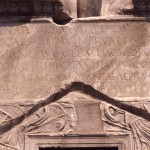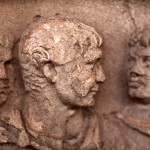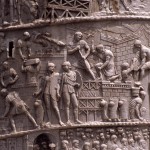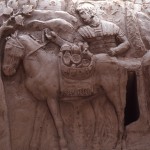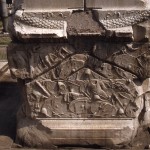This might seem to be a banal overarching question, but it is important to appreciate the original functions of Trajan’s Column to understand the monument as originally completed. These may be characterised as:
1. To mark the height of the ‘mons’ removed for the Forum Traiani complex.
This was explicit in the dedicatory inscription. Excavations in the Column court indicate that there were pre-existing roads and buildings on site, thus the mountain was the Quirinal slope cut back for the Forum piazza, northeast hemicycle, and the Markets of Trajan. While the Column shaft was an artificial unit of 100 Roman feet, it was increased and adjusted by the pedestal and other elements. A contemporary parallel to this concern for topographical modification, and its metric expression, is provided by the Pesco Montano road cutting for the Via Appia at Terracina (Italy). The visitor exits the door onto the balcony with an immediate view to the north-east over the mons.
2. To honour the qualities and achievements of the emperor Trajan in a monumental and figural panegyric.
The crowning statue and the helical frieze both ‘elevate’ the princeps and advertise victory over the Dacians which financed the Forum. Trajan is presented as a paternal commander, exhibiting the formulaic rulership qualities of pietas, clementia, liberalitas, and victorious command; control of a disciplined, multi-cultural army; and concern for the soldiery (campsite choices, adlocutiones, victories without loss of ‘Roman’ blood, medical support, rewards). He expanded the empire and spread Roman urban civilisation into barbaricum.
3. To honour the achievements of Trajan’s army, principally through the helical frieze.
On the frieze citizen forces were paramount, presented as disciplined and technically accomplished, held in reserve during battles, but active in hi-tec sieges. They functioned as acculturators by spreading Mediterranean urbanism and architecture through their construction of military installations, clearance of forests and road-building. Attentive to the gods and to the emperor, they also provided much of the pageant of victory. Legionary titles and signa crowning the basilica façade and colonnades of the Forum linked this element of the Column frieze with the wider complex. Auxiliary troops served faithfully and were rewarded through Trajan’s liberalitas, fulfilling all the other non-technical military functions. The range of irregular troop types reinforced eulogy of Trajan’s generalship qualities.
4. To provide the historical context of events in the Dacian Wars.
Through a more or less coherent narrative on the helical frieze, key historical and topographical points were presented on vertical axes to improve viewer comprehension and to emphasise cardinal achievements (Victory between wars, Danube bridge, capture of treasure, death of Decebalus and presentation of his severed head). These key episodes and symbolic elements were strung together with logically organised generic images (march, construction, adlocutio, sacrifice, battle, siege, submission), always subordinated to panegyric intent.
5. To reinforce credible Trajanic victory for the metropolitan audience.
By presenting the veristic and ethnically specific barbarian spolia on the pedestal reliefs victory beyond far imperial frontiers was given detailed immediacy. The sculptures was referenced by the panels on the Basilica Ulpia façade and by with the bound barbarian statues around the Forum piazza. Trajan’s triumphs, triumphal games and coin issues had already educated the audience about warfare events, barbarian peoples and barbarian material culture. It was vitally important to exclude any suggestion of fabrication or exaggeration in the light of public cynicism, generated, apparently, by Domitianic triumphal staging.
6. To provide a belvedere in the form of the elevated balcony for viewing the Trajanic metropolis.

Quirinal slope cut back for the Forum of Trajan, as seen from the balcony of Trajan’s Column, looking ESE.
The height of the removed mons could be best appreciated by mounting to the balcony. With the lower elevation reconstruction of the Basilica Ulpia and the asymmetric positioning of the Equus Traiani base, the two most prominent statues of Trajan in his Forum were intervisible. A clear appreciation of the magnificence of the whole Forum complex was also facilitated. Beyond the confines of the Forum a number of Trajanic building projects were also viewable to advantage from the balcony, notably the Thermae Traianae on the Oppian Hill to the east-south-east, dominating the Amphitheatrum Flavium and the Thermae Titi. To the south the Forum Iulium had also been heavily remodelled under Trajan, and a Trajanic triumphal arch stood on the Capitol to the southwest. Views north-westwards took in the Campus Martius, perhaps already planning intervisibility with the projected annular balcony of the Pantheon. This belvedere was the principal factor preserving the Column while the rest of the Trajanic Forum complex was stripped away over time.
